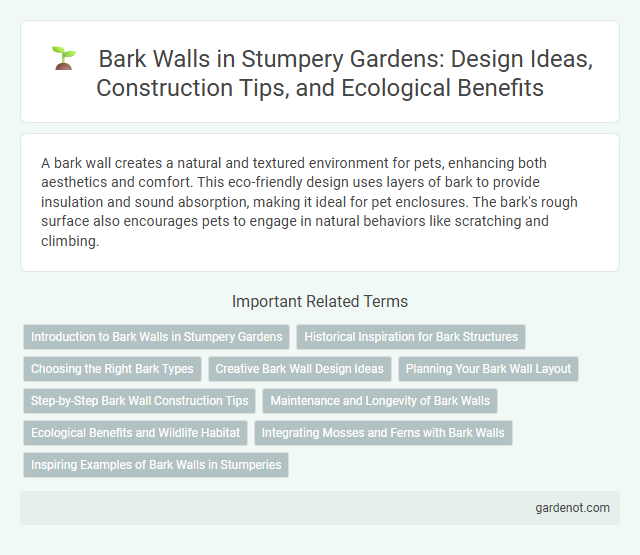A bark wall creates a natural and textured environment for pets, enhancing both aesthetics and comfort. This eco-friendly design uses layers of bark to provide insulation and sound absorption, making it ideal for pet enclosures. The bark's rough surface also encourages pets to engage in natural behaviors like scratching and climbing.
Introduction to Bark Walls in Stumpery Gardens
Bark walls in stumpery gardens serve as natural, textured backdrops that enhance the woodland aesthetic and support biodiversity by providing habitats for mosses, lichens, and insects. Constructed from various tree barks, these walls contribute to moisture retention and soil stability, crucial for cultivating shade-loving plants. Integrating bark walls into stumperies enriches the sensory experience and promotes sustainable garden design by utilizing organic, renewable materials.
Historical Inspiration for Bark Structures
Stumpery bark walls draw historical inspiration from Victorian-era garden art, where botanists and gardeners displayed tree roots and bark to mimic natural woodland environments. These structures emphasize textural variety and organic forms, reflecting 19th-century appreciation for rustic aesthetics and plant morphology. The use of bark as a primary material showcases traditional craftsmanship rooted in ecological design practices.
Choosing the Right Bark Types
Selecting the right bark types for a stumpery bark wall depends on durability, texture, and moisture resistance to support moss and fern growth. Cedar bark offers natural rot resistance and a rugged texture ideal for outdoor installations, while pine bark provides a softer, more porous surface that retains moisture effectively. Incorporating a mix of hardwood and softwood barks enhances biodiversity and structural integrity, optimizing the bark wall's aesthetic and ecological function.
Creative Bark Wall Design Ideas
Creative bark wall designs transform natural textures into stunning focal points for indoor and outdoor spaces. Utilizing varied bark types, such as cork oak or cedar, enhances the wall's visual depth and rustic charm, while incorporating geometric patterns or layered effects adds a modern twist. Combining bark with greenery, LED lighting, or mixed materials like stone creates unique, eco-friendly walls that elevate aesthetic appeal and sustainability.
Planning Your Bark Wall Layout
Carefully measuring the designated area ensures precise planning for your bark wall layout, maximizing visual impact and structural stability. Selecting a variety of bark types and textures enhances the natural aesthetic and promotes biodiversity within the stumpery. Positioning the bark pieces with intentional gaps allows for air circulation and moisture control, preventing decay and supporting healthy plant growth.
Step-by-Step Bark Wall Construction Tips
Start by selecting a sturdy frame made from weather-resistant wood to ensure durability for your bark wall. Securely attach a breathable mesh or backing material to support the bark pieces and allow for airflow. Carefully layer and fix natural bark segments onto the frame using galvanized nails or screws, overlapping the pieces to create a textured, rustic appearance while preventing moisture buildup.
Maintenance and Longevity of Bark Walls
Bark walls require regular inspections to identify and replace damaged or deteriorating bark pieces, ensuring structural integrity and aesthetic appeal. Applying protective treatments such as water repellents and fungicides helps prevent decay and insect infestation, significantly extending the wall's lifespan. Proper drainage and ventilation around the bark wall further enhance durability by reducing moisture buildup and promoting natural drying.
Ecological Benefits and Wildlife Habitat
Bark walls in stumperies provide significant ecological benefits by promoting natural decomposition and nutrient cycling, which enriches soil health and supports surrounding plant growth. These walls serve as vital wildlife habitats, offering shelter and nesting sites for insects, amphibians, and small mammals, fostering biodiversity within garden ecosystems. The textured surface of bark walls also aids moisture retention, creating microhabitats that sustain various fungi and beneficial microorganisms.
Integrating Mosses and Ferns with Bark Walls
Integrating mosses and ferns with bark walls creates a rich, textured environment that enhances the natural aesthetics of a stumpery. Mosses retain moisture and provide a lush green carpet, while ferns add architectural layers and varying leaf shapes, contributing to biodiversity. This combination not only supports habitat diversity but also improves the microclimate by regulating humidity and temperature around the bark wall.
Inspiring Examples of Bark Walls in Stumperies
Bark walls in stumperies showcase textured, natural designs that highlight the beauty of tree bark patterns and organic materials. Stunning examples include multi-species bark mosaics that create rustic backdrops for shade-loving ferns and mosses. These bark walls enhance biodiversity by providing diverse microhabitats while adding visual interest and structural depth to woodland garden landscapes.
Bark wall Infographic

 gardenot.com
gardenot.com